May blog
Fabio Gomes
From the warmth of the Brazilian Northeast I bring you a lyric that tells much about our people and the invention of one of our most traditional and plate. Then I'll tell you why the food manufacturing industry cannot be part of the solution unless it is enforced to take this position. This month I also tell a tale of how food designers make people feel that ultra-processed products taste good. Finally, in the May joke of the month I bring you some (literally) moving evidence of why Big Snack and Big Drink is part of the problem.
Culinary tradition
A taste of Brazil
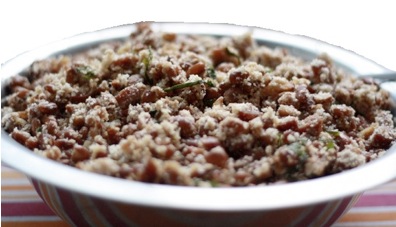
Long ago beginning even in the 16th century, at a time in history before railways or even roads were built, the transportation of goods (including food) in the backlands Brazil, if there were no rivers, was done in the back of animals such as mules, donkeys and horses. The troops (tropas in Portuguese), as they were called, used to travel for around 40 kilometres a day, connecting sources of production to villages, and created many villages and cities, some of which grew into cities. The tropeiros, the drovers who rode with the tropas, gave their name to what remains one of the most traditional dishes of Brazil: the tropeiro bean. Tropas and tropeiros journeyed all over the country for centuries, so this dish does not originate in a given Brazilian state or region, so you cannot say it is typical from Paraíba or Minas Gerais, it is truly Brazilian.
The recipe? The simplest! Beans (black, brown, green, red, choose your favourite), manioc (cassava) flour, green kale, and dried meat. This dish includes what some historians consider to be the three aspects of the colonial Brazilian cuisine: beans, flour and dried meat. (1) Hooray to our creators of the tropeiro bean. Let's celebrate it with our great composer and musician Luiz Gonzaga, born in the countryside of the state of Pernambuco, the King of Baião, as he became to be known, who learned to play his accordion with his father, after the daily journeys of work. Below he reminds us the hard life of the tropeiros, in this case the tropeiros of Borborema (a city from the state of Paraíba, in the Northeast of Brazil)
Drovers of Borborema
(Tropeiros da Borborema)
Crack the vicious rawhide!
(Estala relho malvado)
My theme today is to remember
(Recordar hoje é meu tema)
And to see again the old-time drovers of Borborema
(Quero é rever os antigos tropeiros da Borborema)
Here are troops of donkeys come from the backlands,
(São tropas de burros que vêm do sertão)
Bringing their bales of skin and cotton,
(Trazendo seus fardos de pele e algodão)
Stepping slow, galloping only when hungry.
(O passo moroso só a fome galopa)
All passing over the previous tracks,
(Pois tudo atropela os passos da tropa)
The hard whip cutting into their backs,
(O duro chicote cortando seus lombos)
Their hooves injured by fallen stones.
(Os cascos feridos nas pedras aos tombos)
Thirst and dust, the sun that beats down
(A sede e a poeira o sol que desaba)
On the rolling road that never ends.
(Rolando caminho que nunca se acaba)
Reference
- Silva PP. Farinha, feijão e carne-seca. São Paulo: Senac São Paulo, 2005.
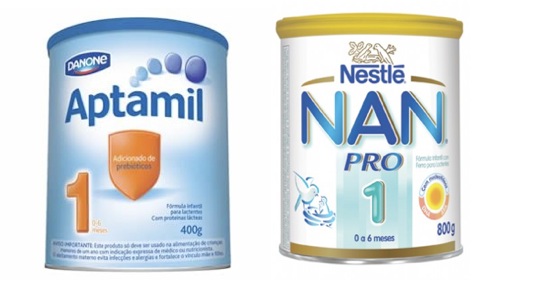
'The food industry is part of the solution.' Or, 'We can solve nutrition problems only with partnerships with the food industry.' Readers of this column must be familiar with such sayings. I hear them all the time when I am in Europe and North America, and now, sorry to say, increasingly often in the South also. Here, I take 'the food industry' mainly to mean the manufacturers of ultra-processed products, the most powerful of which are transnationals. Two examples are shown above: baby formula, ultra-processed by definition, as manufactured by Danone, Nestlé, and other big companies. Other than baby formula, ultra-processed products are typically ready-to-heat or ready-to-eat, energy-dense, fatty, sugary or salty, 'fast' or 'convenience' packages, often with long shelf-lives, in the form of meals, dishes, foods, snacks, and drinks
The view from the North
Let's start from the perspective of countries in the North, like the USA and the UK, where half or more of what is eaten is in the form of ultra-processed products. Customers and consumers – and citizens – in such countries are subject to food systems in which Big Snack is dominant, and where these transnational corporations decide what to manufacture, distribute, advertise and sell.
People in such countries who see economic globalisation, the dissolution of nation-states sovereignty, and the rise of 'economic multinational-states' as natural and inevitable transformations, are likely to feel correspondingly relaxed about their national food systems being dominated by multinational corporations. After all, most people in such countries are used to the movie industry being dominated by Hollywood. At the same time, they are likely to want to be able to buy and consume healthy food, and provide healthy food to their children. It follows that they will want – indeed need – to believe that Big Snack has their interests at heart and is part of the public health solution.
The view from the South
But seen from the South, and a country such as Brazil where less than one third of what is eaten currently is in the form of ultra-processed products, there is an option. The other two-thirds is in the form of fresh, lightly processed or traditional foodstuffs and food and drinks. So people in such countries, including families with little disposable income, have actually or potentially a better and greater sense of what they are eating and giving to their children.
But as the proportion of ultra-processed products in food systems increases, people start to lose the sense of choices, and all the more so when ultra-processed products and massively advertised. This replacement of traditional food with transnational products is happening all over the world. Big Snack is actually creating the problem that it is increasing positioned as able and willing to solve. This is a sick joke.
The industry view
It's easy to see the view of the food manufacturers. Their duty is to increase product share, turnover, and profits. So take Brazil again, with its 190 million people. Do the Big Snack corporations collectively want to increase the proportion of their products purchased and consumed in Brazil, from say 25-30 per cent, to 50-70 per cent? Of course they do! And what are they doing? Spending billions of dollars on advertising, including to children, hiring the most influential lawyers in the country to say food regulations are unconstitutional, funding environmental and physical activity programmes, and among many other things sponsoring nutrition, medical and agriculture congresses to influence professionals to become their advocates.
In Brazil, each year 3 million children are born. Suppose all children born in Brazil in a given year were fed with baby formula from birth up to 6 months of age. The price of an 800g can of baby formula in Brazil is around $US 25 and lasts one week. If all the three million Brazilian children were fed by these formulas instead of human milk until the age of 6 months, this would add up to around $US 2 billion spent on baby formula every six months. Nestlé, Danone and other formula manufacturers affirm that 'breast is best', and state that they abide by the WHO code on advertising and marketing of breastmilk substitutes. But would they seek to prevent a trend towards less breastfeeding and more bottlefeeding? This seems unlikely to me.
The ultimate aim of the transnational corporations is to teach the world to snack on their products. This is not in the public interest. What we as public health professionals are trying to drive down, they are pushing up – with massive resources, and also increasingly with the assent and even approval of governments and UN agencies.
So, when you are speaking from a country with high shares of ultra-processed products, and if you are relaxed about economic globalisation and the ascendancy of the transnational food and drink corporations, please remember the South. Please say, if this is what you believe, 'The food industry is part of the solution in my country', or ''In my country we cannot solve nutrition problems without partnering with the food industry'. This will help citizens and public health nutrition advocates from countries with lower shares of ultra-processed products. This will help us to continue to fight to protect the fresh, minimally processed and traditional foodstuffs that are part of our national identity, culture, and family life, and which are also part of the prevention of disease and promotion of well-being.
Food marketing
Tasty bottles
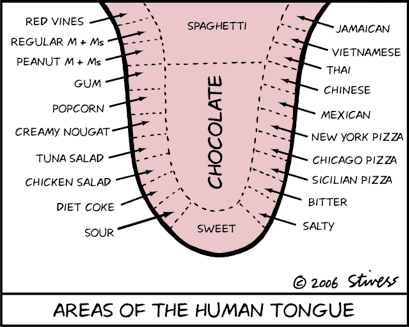
How come people say they like or dislike specific foods or products? What makes people say that food is tasty? What makes you say that that a product tastes good right from the first taste? Is this all natural? No, it is not! Great minds have been at work.
In Malcolm Gladwell's book Blink here is a story about chairs. The furniture maker Herman Miller hired two industrial designers to come up with a new chair. The idea was to create a totally different one, something extremely ergonomic. In 1992 they started testing. For one design the comfort ratings were good, but the aesthetic ratings were awful. People thought the chair was very ugly. But Herman Miller insisted and launched the chair you can see below, with maximum marketing muscle. By the end of the 1990s the design community was persuaded and enchanted, the chair became a product placed in movies and commercials, and thus the best-selling chair in the history of the company. So? What this tells us is that we can be taught new and commercially attractive ideas of what is good or bad, or nasty or nice, whether the product is a chair or a cookie.

Malcolm Gladwell also includes a riff on margarine, and specifically on a genius psychologist and marketing innovator. This was Louis Cheskin, whose theory was that people tend to transfer sensations they get from the look of products to the actual products. Thus, in 1940, sales of butter in the US were four times those of margarine, and it was generally assumed that nothing much could be done about this. Louis Cheskin had a feeling this wasn't just a matter of taste. At that time margarine was white, so in areas where this was legal he got a company to colour one of its brands yellow to look like butter. This worked. For Unilever he also changed the wrapping from waxed paper to foil, and used a crown as a symbol over the brand name 'Imperial'. With these cosmetic changes, people could not distinguish the product from butter, and sales soared. Helped by shortage of butter in the Second World War, by the mid-1950s sales of margarine in the US had overtaken those of butter.
The Cheskin company also studied two types of cheap brandy, Christian Brothers and E & J. After years of being dominant brand Christians were starting to lose out to E & J. Nobody knew why. Prices and availability were similar. Advertising was at similar levels. Blind taste test results were the same. The first experiment involved printing the respective brand names on glasses. This done, people preferred Christian Brothers – contrary to what was happening in the market. The second experiment showed the brand on each glass and also the bottles, and this done, people preferred E and J. People liked the bottle better. Christian Brothers had the righteous name, but the E&J bottle (below) looked kind of old-fashioned and authentic. Once shown the bottle, drinkers felt that the product was superior.
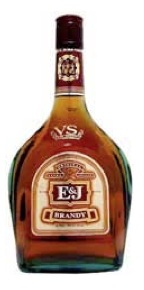
Marketing and packaging play with our unconscious, driving us to like products we otherwise would like much. In this way, people can be made to believe that an ice-cream in a round container tastes better than the same ice-cream in a rectangular package, or that a lime soda tastes better and more actual lime in it, if the label includes a lot of yellow. So watch out!
Reference
- Gladwell M. Blink: the power of thinking without thinking. New York: Back Bay Books, 2005.
Joke of the month
Hop skip and jump with Shrek
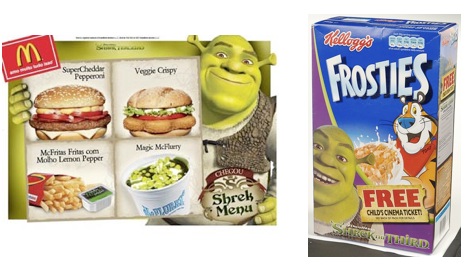
To experience the joke this month, please click here, and watch the video. It stars the previous US President George W Bush, his Secretary of Health, and a bunch of chief executives of a number of transnational food and drink manufacturers. The topic was childhood obesity, agreed to be a national crisis, and how to prevent it.
As you will be able to see in the first scene of the video, on George W Bush's left we have Indra Nooyi, CEO of PepsiCo. The video indicates who is representing who in the table, so you will see representatives of Kellogg's, Coca-Cola (notice the product placed in front of him), McDonald's, DreamWorks, and of Nickelodeon, General Mills and Kraft. The task of the group was to agree and support a coherent national strategy, which they did. That's wonderful, you might think. But... you may already be wondering why was it that the advisors to the President deemed to be most appropriate, were the big bosses of the corporations whose products make children overweight and obese. Could it possibly be that they collectively had agreed to change their ways? Before you watch the video, guess what the agreed strategy was. You may mark more than one option, from the list below.
- An end to the manufacture of junk products.
- Laws to ban advertising of junk products to children.
- Likewise, for advertising to parents junk products aimed at children.
- A video starring Shrek aimed to get children to be physically active.
- Taxes on junk products.
Well OK, you have I'm sure spotted the option that diverts attention away from the impact of ultra-processed products such as those manufactured by the firms whose representatives advised the President and his Secretary of Health. After George W and his Secretary of Health had said their pieces, into the room came another lumbering great piece of product placement, the star of option number four above. This was Shrek, the Dreamworks™ character, who as you see above is already used to promote various ultra-processed products. Shrek: genial, lovable – and obese.

Reference
Acknowledgement and request
You are invited please to respond, comment, disagree, as you wish. Please use the response facility below. You are free to make use of the material in this column, provided you acknowledge the Association, and me please, and cite the Association’s website.
Please cite as: Gomes F. A taste of Brazil, and other items. [Column] Website of the World Public Health Nutrition Association, May 2011. Obtainable at www.wphna.org
The opinions expressed in all contributions to the website of the World Public Health Nutrition Association (the Association) including its journal World Nutrition, are those of their authors. They should not be taken to be the view or policy of the Association, or of any of its affiliated or associated bodies, unless this is explicitly stated.
This column is reviewed by Geoffrey Cannon. My thanks to Cristiano Boccolini for helping me with the baby formula example. Many thanks to the members of the Food Marketing Regulation Front for sharing the video that featured the Joke of the month.






